Two on Turneffe Island, BelizeContents of this Issue: Two on Turneffe Island, Belize Dive: The Ultimate Guide to 60 of the World’s Top Dive Locations Thumbs Down Advanced Diving Placencia, Belize Court Upholds Fish Feeding Ban Editorial Office: Ben Davison Publisher and Editor Undercurrent 3020 Bridgeway, Suite 102 Sausalito, CA 94965 — Turneffe Island Lodge and Turneffe Flats from the April, 2005 issue of Undercurrent
Dear Fellow Diver: Once upon a time, in the very short history of scuba diving, one could go to Bonaire or Cozumel or Ambergris Caye and escape civilization. No more and never again. But in February I did get away from civilization at two secluded outposts in Belize that are accessible only by a thirty-mile boat ride. The nearest settlement might be a couple of old fishermen in a ramshackle hut, and the nights are free of sputtering autos, neon lights, and Fox blasting its bias into your room under the guise of news. The only sounds are lapping waves, the lights are from the heavens, and the bias favors nature and not development. Paradise, I should think, for any diver who can go a week with only T-shirts, shorts, and a paperback. Turneffe Island — actually 32 islands — is the largest coral atoll in the Caribbean and an integral part of Belize's Barrier Reef, the second longest on our planet. An island millions of years ago, it has slowly eroded to below sea level, allowing coral to build and mangroves to bloom. The 28,000-acre atoll is up to 10 miles wide and 30 miles long. I dived first from Turneffe Island Lodge, then journeyed ten miles north to Turneffe Flats Resort. Each is excellent, but one clearly serves divers better than the other. Turneffe Island Lodge is billed as “a private
Caribbean island,” and indeed it is the only occupant
of its own 14-acre caye, with a manicured landscape
and a raked beach covered with waving palms and blooming
bougainvillea. Yards from the ocean, yellow two story Caribbean clapboard buildings hold six
large guest rooms, nicely finished in island
decor. While fishermen come here in search of bonefish, permit, and tarpon, it's most of all a diving lodge, with three dives a day and night dives once a week. A sign in the dive shop says “we reserve the right to slap any diver upside the head if it makes us feel better,” but this was a great crew, and no upsides were taken by the three Belizean divemasters, Brad, Marcel and Bo, Manager Assaf Pery, his assistant, Jonathan Yachin and his partner Ida, or the two boat drivers. All were helpful, toting gear to the boat and cleaning it after the dive. They passed fresh towels and sweet orange slices after each dive. They kept a personal log book asking the length and duration of each dive and, when we left, gave us a weekly logbook of our dives including the sites, bottom times, and the fish and critters we saw. During my week, the 28 American guests and one French couple ranged from X-ers to Boomers, and many were novice divers. They organized us into two groups based on experience and assigned us to one of two open 27-foot boats with tank holders down the middle. During the 5-10 minute ride to the sites, we donned tanks and gear while sitting on top of the narrow gunwales. It was crowded and awkward, but the crew helped and even defogged our masks. Getting back on the boat required removing gear and climbing a small Christmas tree ladder with one wobbly hand rail. It was tricky. There were no handholds on the side of the boat so I had to push off to keep from getting slammed by it. One poor soul tossed his “cookies” after every dive until he learned to hang at 20 feet until the divers were all back onboard. A tag line was tossed out only after four women divers from New York requested it. I was first down on the checkout dive at Permit's Paradise and, while it was supposed to be a group thing, it was a good 15 minutes before the group assembled, the novices having to deal with improper weighting, ear clearing, or just getting it together. Just as we got under way, the divemaster honked his horn; someone had already breathed his aluminum 3000 down to 1700 psi. So rather than a gentle drift, I tooled around at 40 feet, though there wasn't much happening. The water was 79 degrees. On my dives, I did not see lots of schooling fish, but most Caribbean species are in these waters, and some are bigger than life. At Secret Spot, the wind and current swept sand along the wall, but not as much as the sandstorm created by a big 6-foot Southern stingray. A 10-foot nurse shark covered with remoras took off at the sight of us. At the wall I enjoyed a close-up encounter with a spotted eagle ray. At Cutthroat, several eagle rays circled, while a 6-foot hawksbill turtle who has lived there for seven years seemed content to give divers a ride, not the sort of activity one would expect from an eco-lodge sort of place. By the third dive of the day our boat of nine was down to four divers, the others content to snooze in the hammocks. The seas were rough all week, but the wind kept the mosquitoes and no-see-ums at bay. Tuesday at sunrise we boarded “Miss Bella,” a twin 240-hp Pro48, for a 90-minute bone-jarring ride through swells, breakers, and rollers to the Blue Hole, a sinkhole made famous by Jacques Cousteau's 1970 Calypso exploration. Passing the Nekton Pilot and Peter Hughes' Sun Dancer en route, we were the first to arrive at the Hole. A thousand feet in diameter, the Blue Hole plunges to 4000 feet. Divers drop en masse to 130 feet for five minutes, enough time to get a little narked. Bull and reef sharks (apparently chummed to make the site more interesting), large black groupers, and bigeyed jacks circled at the safety stop. When we surfaced, five dive boats had arrived. It's a dive to enter in everyone's log book once, enough for most folks.
Then on to Half Moon Caye, where an observation deck above the forest canopy offers an eye-level view of red-footed boobies nesting. Frigate birds, who share the treetop habitat, were puffing their red gullets, an act of male prowess. The half-mile sandy root-covered trail meanders through littoral forest complete with information signs. A hermit crab ambled across the path; several iguana sunned on tree branches. Having degassed, we went on to perhaps the best dives of the week: Half Moon wall and the Aquarium at Lighthouse Reef. The walls are covered with black and deep water fans, whips, and an elephant ear sponge. Bermuda chubs, sergeantmajors, yellow snappers, and a grouper, conditioned to the boat, become frenzied when Bo offers bread. The beauty of these two dives is the chalk-white sand embracing the drop-off before reaching the wall. It inspired Assaf to take off his fins and walk barefoot in the underwater sand. The reef appears to be more pristine with a greater variety of coral, including one perfectly shaped orange elephant ear sponge. Now the Elbow, too, is a great drift dive with plenty of fish. Next to the Blue Hole, other resorts will motor an hour to dive this popular site known for seasonal schooling hammerheads. Coincidentally, I met up with some of my dive buddies in Belize City. While I saw schools of permit, an amberjack and a pompano, they said they saw 200 hammerheads. If they exaggerated by 1000 percent, I'm still impressed. But I did see a 500-pound Goliath grouper surrounded by snappers chasing it for leftovers. Belize's barrier reef has some macro as well. I saw several seahorses, a variety of blennies including the diamond, and several clusters of yellow-headed jawfish. A shy white-spotted toadfish couldn't be coaxed out of his hole. Hurricanes are a way of life here, so some reefs have some patches of coral rubble. Turneffe Island Lodge is managed by two friendly watchdogs, Cashew and
Gator, and ably assisted by Rona Ayalon and her partner Assaf, both Israeli.
They follow a tradition, enforced a couple decades ago by then-manager and legendary diver Hugh Parkey (now deceased, due to a heart attack while diving),
of having everyone set watches back an hour to “Turneffe time” to take
better advantage of daylight. At 6:30 a.m., coffee, sweet rolls, and fresh
orange juice are quietly placed outside each room. Breakfast is 7:30 a.m.
(Maybe it should be earlier, since it never got to the table hot.) Each meal
is fully served and guests mingle family style. (I sat mum, listening to divers
talk about planning their dive vacations by reading Undercurrent, wishing
I could say, guess what? This trip will be in the next issue!) The food
is excellent, and dinner typically included pork loin or chicken accompanied
by several al dente vegetables and a pasta. Homemade bread was also passed,
then homemade pie or cheesecake. So here's an adult destination for divers, fishermen and fisherwomen, snorkelers, or beach bums, with good food, good people, and surroundings yet untouched. If you have a nondiving partner, there is guided fishing. Twice daily a guide takes snorkelers to a different beach. There are Hobie cats, sunfish, and kayaks (and maybe a rare glimpse of a manatee). There is even a rarely used swimming pool, a place for a dip after joining an energetic staff-led beach volleyball game around five. Turneffe Island Lodge is a unique place for a true dive vacation, and I was sorry to go, but my trip wasn't over yet. An hour's boat ride up the atoll, about 10 miles north of Turneffe Island Lodge, lies Turneffe Flats Resort. There is no charge if you'd like to return on the Belize City charter, but a direct transfer would have a fee. Turneffe Flats is another private destination that offers both diving and fishing. Turneffe Flats Resort is perched on a scenic northeastern point of Blackbird Caye. A 7-iron chip from Belize's 160-mile barrier reef, the Flats is surrounded by small red mangrove atolls. Turneffe Flats started in the 80s as a bonefishing resort run by two young South Dakotans, Craig Hayes and Doug Moore, who employed “Juni” Marin and “Blue” Westby, two of only a handful of bonefishing guides in Belize. Craig is now the owner and operator, along with his wife, Karen, but both were in the States during my visit. Holding down the fort was Scott Stevenson, a fishing guest and visitor for the past 23 years. Mutts Buddy, Anchor and Scuba kept watch over him, while a night watchman kept an eye on everything. The lodge has 12 rooms and can accommodate 22 guests, in addition to the
owners' “big house,” with an attached living room and kitchen. Spacious, air-conditioned, duplex-style
guest cottages are located smack
on the beach. When it's fishing season (spring and summer), the occupancy is weighted toward fishers. Other weeks, the place might be filled with divers. The Flats offers three dives daily (17 during the week) from a 31-foot Mako with compartments to store dive gear, oxygen, and flotation devices. It has a blue awning for sun protection. Entry is a backward roll, return is by a sturdy but narrow ladder. Fresh fruit and Clif bars are served after dives. Sixty sites, they say, are located within 30 minutes of the resort. A larger Pro48 custom dive boat is available whenever there are more than six divers or for longer trips to the Blue Hole or Elbow. During my stay, there were two novice divers content to do a single or two morning dives, and me. The dive boat leaves at 8 a.m. for two-tank dives. Two divemasters, Anne Robinson and local Danielle Dominguez, team with Frederick Lopez, who captains the boat. The Flats has an unnecessarily restrictive dive policy—return to the boat with 800 psi or in 40 minutes, whichever comes first, at least when novice divers are present. Anne, who just started working here, was firm on this policy, and when I mentioned it to the management, Scott gave me the impression that this is her program, and, because she just came from schooling at Pro Dive, what she says rules. This will surely keep experienced divers away, though she is conscientious with the novice divers. Each entered the water one at a time, hung on the tag line, and descended with the group. She did accommodate my request to descend upon entry. Anne planned drift dives at Lindsey's Back Porch followed by Cockroach Caye. She read the Lodge log to locate the sites, but we missed the mark both times (neither Frederick nor Danielle could help find them). Instead, we swam an ordinary deep landscape. They managed to find the wall for the second dive, but it was too deep, having made just an hour's surface interval. After a long swim over sand, we ended up in 20 feet of water drifting in surge, admiring gorgonians and whips while trying to avoid fire coral. And bottom time was enforced. Dive sites are marked on a GPS on the large boat; on the small boat it was triangulation or a good guess. One afternoon dive was canceled because I was the only diver. One day I decided to wade the flats with a fly rod in hand, sweating in the humid 82° temperature. Casting a nifty but heavy 9-foot graphite rod into 25 mph winds was challenging. Divers never see bonefish because the speedy runners tail for food in the muddy, shallow water of the mangroves. But a highlight of my fishing day was enjoying a polarized-glasses view of barracuda, eagle rays, triggerfish, blue boxes, grunts and chubs, and yellow and red starfish in the shallow water. While I fished, my two fellow divers dived Tarpon Cut, a 70-foot sloping wall. They spotted an eagle ray, queen triggers, spotted drum, schools of Creole wrasse, and a small yellow stingray. At Sponge Shop, they made a 60-foot dive admiring numerous barrel and blue and green vase sponges. Typical nice Belizean dives, but limited by the draconian bottom-time policy. Each morning at 6:30 a.m. a gentle tap on the door signals the delivery of a pot of hot coffee and freshly squeezed orange juice. The food was delicious with more informal family-style service than Turneffe Island Lodge, which serves each guest individually. Food was brought from the kitchen on a rolling cart. The dinners were excellent, snapper for example, with fresh vegetables, homemade bread and key lime pie, and a barbecue night where they cooked ribs and chicken on the beach but served it in the dining room. Lunch was lighter and included, say, a delicious chicken salad and fresh fruit, while fishers were given the choice of a variety of sandwiches and chips. A series of hurricanes, Mitch in 1998 and Keith in 2000, destroyed the beach and dock, damaging most of the buildings and wiping out 120 palm trees. The catastrophe is poignantly illustrated by a photographic diary in the lounge. The Flats responded with a complete renovation. They doubled their dining space and added air-conditioning. The sizable lounge has a bar and sitting area. In one corner, there is a slower than dial-up toggle cursor laptop. E-mail, if you have the patience, is complimentary. There is a library with DVDs, and another corner has a fly-tying desk. Guests, both an older and younger crowd, mixed and mingled during cocktail hour. There was an equal number of 30-somethings. Several men came to fish and their wives painted or quilted while they fished. Abel Coe serves as bartender and snorkeling and adventure guide. Three of the largest nesting sites for American saltwater crocodile are on neighboring atolls. There is also the rare opportunity to observe a manatee with Abel in the lead. The dive program and the guaranteed sites visited by Turneffe Island Lodge clearly excel over those at Turneffe Flats. As Anne get more comfortable, perhaps it will loosen up, but before going I'd contact her and clearly establish your needs and her ground rules. On the other hand, a novice might do just fine. Either resort is an excellent place to kick back and leave civilization behind.
|

I want to get all the stories! Tell me how I can become an Undercurrent Online Member and get online access to all the articles of Undercurrent as well as thousands of first hand reports on dive operations world-wide
| Home | Online Members Area | My Account |
Login
|
Join
|
| Travel Index |
Dive Resort & Liveaboard Reviews
|
Featured Reports
|
Recent
Issues
|
Back Issues
|
|
Dive Gear
Index
|
Health/Safety Index
|
Environment & Misc.
Index
|
Seasonal Planner
|
Blogs
|
Free Articles
|
Book Picks
|
News
|
|
Special Offers
|
RSS
|
FAQ
|
About Us
|
Contact Us
|
Links
|
3020 Bridgeway, Ste 102, Sausalito, Ca 94965
All rights reserved.

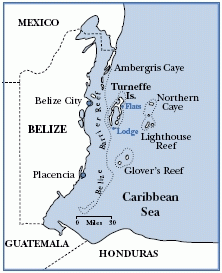 Louvered windows conceal a gorgeous
ocean view forsaken for the comfort of air
conditioning, but one can catch the breeze
by relaxing on the screened porch. A mirrored
vanity sink is next to the bathroom,
which has a sizable shower and a toilet area
about as wide as an airliner's loo. For an
extra $100/night, you can hunker down in one
of their two-room cottages with a private
screened porch with an additional outdoor
shower and a large bath with a dressing room
next to the bedroom.
Louvered windows conceal a gorgeous
ocean view forsaken for the comfort of air
conditioning, but one can catch the breeze
by relaxing on the screened porch. A mirrored
vanity sink is next to the bathroom,
which has a sizable shower and a toilet area
about as wide as an airliner's loo. For an
extra $100/night, you can hunker down in one
of their two-room cottages with a private
screened porch with an additional outdoor
shower and a large bath with a dressing room
next to the bedroom. 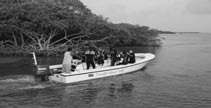
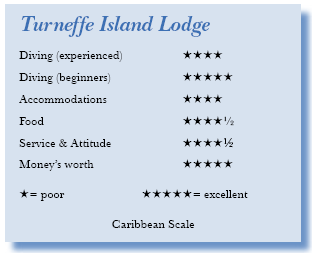 Lunch could be an enchilada, pasta or
pizza, always served with a homemade dessert, thanks to a good pastry chef.
I often spoiled my dinner beforehand, snacking on shrimp ceviche and downing
one or two of bartender Sherman's blended margaritas, banana daiquiris, and
piña coladas. After dinner, folks retreated to the game table or the entertainment
center, stocked with the
latest DVDs, to watch one New
York diver's video of the day.
Lunch could be an enchilada, pasta or
pizza, always served with a homemade dessert, thanks to a good pastry chef.
I often spoiled my dinner beforehand, snacking on shrimp ceviche and downing
one or two of bartender Sherman's blended margaritas, banana daiquiris, and
piña coladas. After dinner, folks retreated to the game table or the entertainment
center, stocked with the
latest DVDs, to watch one New
York diver's video of the day.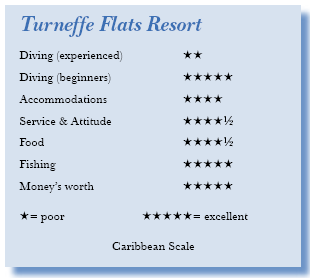 Although a common
wall separates the two cabins,
each room was large with a nicesized
bathroom and a panoramic
view with stereophonic sounds
of crashing waves. Decked porches
did not have screens, which
would make for itchy sitting if
the bugs were out. The Flats lost
most of its beach to a previous
hurricane. I stayed in the owners
' overflow room, and while I
had a view of the ocean, I didn't
enjoy the proximity of the cabins.
A white sandy beach, dotted
with coconut palms, is lined with
four duplex cottages. Essentially,
the Flats is similar to Turneffe
Lodge, a cut below in style and
without amenities (no Neutrogena shampoo, room clocks, or even bathroom
drinking glasses).
Although a common
wall separates the two cabins,
each room was large with a nicesized
bathroom and a panoramic
view with stereophonic sounds
of crashing waves. Decked porches
did not have screens, which
would make for itchy sitting if
the bugs were out. The Flats lost
most of its beach to a previous
hurricane. I stayed in the owners
' overflow room, and while I
had a view of the ocean, I didn't
enjoy the proximity of the cabins.
A white sandy beach, dotted
with coconut palms, is lined with
four duplex cottages. Essentially,
the Flats is similar to Turneffe
Lodge, a cut below in style and
without amenities (no Neutrogena shampoo, room clocks, or even bathroom
drinking glasses).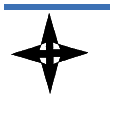 Diver's Compass: Turneffe Island Lodge: All-inclusive package
with 17 dives is $1843; for the private cabin add
$633. . . . The Lodge has a full range of rental gear,
provides open water certification (if class work is done
before arrival, it's an exorbitant $800 for one person,
$550/person for two), resort course, advanced open water,
etc. . . . The liability form is endless and number eleven
states the lodge “makes no representation to me, implied or
otherwise, that the crew will perform safe rescues or render first aid in
the event I show signs of distress or call for aid.”. . . . I was the only
Nitrox diver ($121/week). . . . $1 a minute charge for Internet use. . . .
Guests are transferred by boat twice weekly (Wednesday and Saturday) to
and from Belize City after the 2:00 p.m. Continental flight from Houston
arrives; one-way transfers on other days are $400. Call 800-874-0118,
Diver's Compass: Turneffe Island Lodge: All-inclusive package
with 17 dives is $1843; for the private cabin add
$633. . . . The Lodge has a full range of rental gear,
provides open water certification (if class work is done
before arrival, it's an exorbitant $800 for one person,
$550/person for two), resort course, advanced open water,
etc. . . . The liability form is endless and number eleven
states the lodge “makes no representation to me, implied or
otherwise, that the crew will perform safe rescues or render first aid in
the event I show signs of distress or call for aid.”. . . . I was the only
Nitrox diver ($121/week). . . . $1 a minute charge for Internet use. . . .
Guests are transferred by boat twice weekly (Wednesday and Saturday) to
and from Belize City after the 2:00 p.m. Continental flight from Houston
arrives; one-way transfers on other days are $400. Call 800-874-0118, 